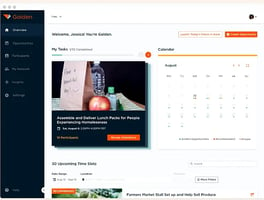How to Transition from Spreadsheets to Volunteer Management Software

If you're still managing your volunteer program with spreadsheets, you’re not alone—and you’re not failing. Plenty of nonprofits and companies start there because it's familiar and free. But as the number of volunteers grows and the work becomes more complex, spreadsheets quickly turn into a time sink. Worse, they can start to break your system instead of supporting it.
That's where Volunteer Management Software comes in. It's not just about replacing rows and columns—it’s about making your operations more scalable, more reliable, and more rewarding for everyone involved.
When Spreadsheets Start to Hold You Back
Most teams don’t upgrade their systems overnight. The shift happens slowly. You start by adding more tabs. You try color-coding things. Then one day, someone misses a shift because they never got the update. Or you’re late sending a report because the data wasn’t where it should’ve been. Sound familiar?
Here are a few common signs it might be time to move on:
1. Your volunteer list is outgrowing your spreadsheet
Spreadsheets are fine for managing ten or twenty people. Once you pass that, especially into the hundreds, sorting by skills or checking availability turns into a chore. You scroll endlessly. You copy and paste things into new tabs. It’s manual, and it’s exhausting.
2. You spend too much time fixing errors
It only takes one typo to throw off an entire week of scheduling. Manual entry is prone to mistakes—duplicate names, missing contact info, mismatched hours. And when things go wrong, the fix always falls on you.
3. Time tracking is a mess
You’re chasing down hours across texts, emails, and handwritten notes. Consolidating that into one clean report becomes a job in itself. Or worse, it doesn’t happen, and your reporting suffers.
4. Volunteer communication is scattered
Need to reschedule a shift? You’re probably bouncing between email threads, phone calls, and maybe even DMs. A proper communication system—like the one built into Volunteer software—saves you from all of that back-and-forth.
If any of this sounds like your day-to-day, you’re not alone. But the good news is: there’s a better way.
Why Volunteer Management Software Is a Smarter Approach

Switching to Volunteer Management Software isn’t just about working faster—it’s about creating a better experience for everyone involved. Volunteers feel more connected. You get your time back. And the whole program feels more intentional.
Here’s what changes when you switch:
- Automation saves time
Tools like nonprofit volunteer management software take care of the boring stuff—sign-ups, reminders, credentialing—so you can focus on your mission. - You see everything in one place
A real-time dashboard shows who’s doing what, when, and where. That visibility helps you spot gaps and make smarter decisions on the fly. - Volunteers get a better experience
With Volunteer scheduling, mobile check-ins, and personalized roles, they’re not just helping—you’re helping them feel seen. - Reporting becomes a breeze
Instead of manually adding hours, use built-in features from Volunteer hour tracking tools to generate clear, polished reports in minutes. - It scales with you
Whether you’re growing a local nonprofit or running corporate volunteer management software for a national brand, the system grows with you—no more reinventing the wheel.
How to Transition Without Losing Your Mind
Switching systems doesn’t have to mean starting from scratch. Here's how to make the transition feel more like an upgrade—and less like a disruption.
Step 1: Clean your current data
Start with a spreadsheet cleanup. Remove duplicates, fix inconsistent formatting, and organize your columns. This will make importing to your new system faster and easier.
Step 2: Choose software that’s actually built for volunteers
There are a lot of generic CRMs out there, but Golden is designed specifically for mission-driven teams. From scheduling to document tracking, it’s packed with features tailored to your needs—whether you’re managing a nonprofit or integrating with Volunteer for Salesforce.
Step 3: Import and configure
Golden makes it easy to upload your spreadsheet and start setting up programs, assigning roles, and adjusting permission levels. No technical wizardry needed.
Step 4: Train your staff and volunteer leaders
Show them how to navigate the dashboard, post opportunities, and view impact reports. Most teams get comfortable within an hour.
Step 5: Let your volunteers know what’s coming
Send out a short message, walk them through what’s new, and highlight how this helps them. You’ll find most people welcome the clarity and convenience.
What If Your Team Pushes Back?
Every system change comes with questions and concerns. That’s normal. Here’s how to handle the most common ones:
“We don’t have the budget for this.”
You’re probably spending more than you realize—just in time and errors. Better tools often lead to better results, which can help you secure grants and retain volunteers longer. In other words: it’s not a cost, it’s an investment.
“We’re comfortable with our current setup.”
That’s fair. You don’t have to switch everything at once. Start small. Try Golden with just one program, then build from there. Often, the results speak for themselves.
“Will it really make a difference?”
Set up one month of activities in Golden. Run a report. Compare it to your spreadsheet method. It won’t take long to see the improvement.
Make the Switch—Without the Stress
Transitioning to Volunteer Management Software doesn’t mean overhauling your entire process overnight. It means replacing what's not working with something that does. And it means giving your volunteers, your staff, and yourself the tools to thrive.
Golden makes that possible. It's flexible, purpose-built, and trusted by teams across sectors. If you’re serious about improving how you manage, recruit, and engage volunteers, check out this guide on Volunteer Management or explore these volunteer appreciation ideas to keep your team motivated.


